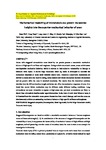Mathematical modelling of microtubule-tau protein transients: insights into the superior mechanical behavior of axon
| dc.contributor.author | Li, Long-yuan | |
| dc.contributor.author | Wu, J | |
| dc.date.accessioned | 2019-03-04T08:03:35Z | |
| dc.date.issued | 2019-03-01 | |
| dc.identifier.issn | 0307-904X | |
| dc.identifier.issn | 1872-8480 | |
| dc.identifier.uri | http://hdl.handle.net/10026.1/13387 | |
| dc.description | Publisher’s embargo period: Embargo set on 04.03.2019 by SR (TIS). | |
| dc.description.abstract |
Axons with staggered microtubules cross-linked by tau protein possess a remarkable mechanical balance of high specific stiffness and toughness. Owing to their viscoelastic nature, axons exhibit stress rate-dependent mechanical behavior, which is relevant to their selective vulnerability to damage in traumatic brain injury. A Kelvin–Voigt viscoelastic shear lag model is developed to elucidate the mechanical responses of axons under transient tensile force. Analytical closed-form expressions are derived to characterize the relative sliding, stress transfer and failure mechanism between microtubule and tau protein while the axon is stretched transiently. The results from the theoretical solutions elucidate how the MT-tau interface length and stress rate affect the mechanical responses of axon. It is found that axonal failure mechanism may be different under different loading conditions. Long microtubules are more vulnerable to rupture at high stress rate, yet short microtubules are likely to detach from microtubule bundles under large deformations. In the view of multi-level failure of axon, it is illustrated how the vulnerable axons protect themselves from overall damage, and how the axon can simultaneously achieve an outstanding mechanical balance of high specific stiffness and toughness. | |
| dc.format.extent | 452-466 | |
| dc.language | en | |
| dc.language.iso | en | |
| dc.publisher | Elsevier | |
| dc.rights | Attribution 4.0 International | |
| dc.rights | Attribution 4.0 International | |
| dc.rights | Attribution 4.0 International | |
| dc.rights | Attribution 4.0 International | |
| dc.rights | Attribution 4.0 International | |
| dc.rights.uri | http://creativecommons.org/licenses/by/4.0/ | |
| dc.rights.uri | http://creativecommons.org/licenses/by/4.0/ | |
| dc.rights.uri | http://creativecommons.org/licenses/by/4.0/ | |
| dc.rights.uri | http://creativecommons.org/licenses/by/4.0/ | |
| dc.rights.uri | http://creativecommons.org/licenses/by/4.0/ | |
| dc.subject | Staggered composite | |
| dc.subject | Biocomposite | |
| dc.subject | Shear lag model | |
| dc.subject | Kelvin-Voigt viscoelastic model | |
| dc.subject | Traumatic brain injury | |
| dc.title | Mathematical modelling of microtubule-tau protein transients: insights into the superior mechanical behavior of axon | |
| dc.type | journal-article | |
| dc.type | Journal Article | |
| plymouth.author-url | https://www.webofscience.com/api/gateway?GWVersion=2&SrcApp=PARTNER_APP&SrcAuth=LinksAMR&KeyUT=WOS:000468259900028&DestLinkType=FullRecord&DestApp=ALL_WOS&UsrCustomerID=11bb513d99f797142bcfeffcc58ea008 | |
| plymouth.volume | 71 | |
| plymouth.publication-status | Published | |
| plymouth.journal | Applied Mathematical Modelling | |
| dc.identifier.doi | 10.1016/j.apm.2019.02.030 | |
| plymouth.organisational-group | /Plymouth | |
| plymouth.organisational-group | /Plymouth/Faculty of Science and Engineering | |
| plymouth.organisational-group | /Plymouth/Faculty of Science and Engineering/School of Engineering, Computing and Mathematics | |
| plymouth.organisational-group | /Plymouth/REF 2021 Researchers by UoA | |
| plymouth.organisational-group | /Plymouth/REF 2021 Researchers by UoA/UoA12 Engineering | |
| plymouth.organisational-group | /Plymouth/Research Groups | |
| plymouth.organisational-group | /Plymouth/Research Groups/Marine Institute | |
| plymouth.organisational-group | /Plymouth/Users by role | |
| plymouth.organisational-group | /Plymouth/Users by role/Academics | |
| dcterms.dateAccepted | 2019-02-25 | |
| dc.rights.embargodate | 2020-2-29 | |
| dc.identifier.eissn | 1872-8480 | |
| dc.rights.embargoperiod | Not known | |
| rioxxterms.versionofrecord | 10.1016/j.apm.2019.02.030 | |
| rioxxterms.licenseref.uri | http://creativecommons.org/licenses/by/4.0/ | |
| rioxxterms.licenseref.startdate | 2019-03-01 | |
| rioxxterms.type | Journal Article/Review |



